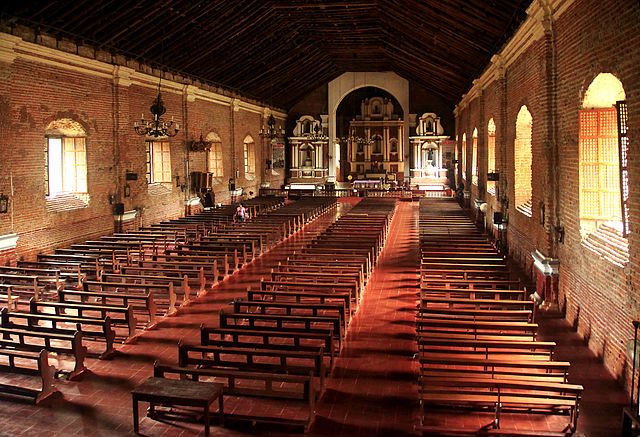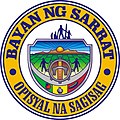Top Qs
Timeline
Chat
Perspective
Sarrat
Municipality in Ilocos Norte, Philippines From Wikipedia, the free encyclopedia
Remove ads
Sarrat, officially the Municipality of Sarrat (Ilocano: Ili ti Sarrat; Filipino: Bayan ng Sarrat), is a municipality in the province of Ilocos Norte, Philippines. According to the 2024 census, it has a population of 26,294 people.[5]
The town is known as the birthplace of Ferdinand Marcos, the 10th President of the Philippines.
Remove ads
Etymology
Cabayugan was how the people called Sarrat by its first settlers led by the village chief Minagel (Maingel) Bang'at and his wife Sarrah, before the arrival of the Spaniards in the latter part of the 16th century.[6] Sarrat is a compound of the couple's names and is believed to have been coined by their son, Garo.
History
Summarize
Perspective
Records show that Sarrat was initially established in 1724 in a location next to present-day San Nicolas at the southern bank of the Padsán River.[7] The town was initially named San Miguel when the Augustinians erected a parish coinciding with the gaining of its township status on September 29 that year.[6] In 1815, what became known as the Sarrat Rebellion broke out in the town, which was described as the bloodiest of the Ilocano uprisings in the early 19th century and resulted in the division of Ilocos into two provinces by the Spaniards to maintain their effective control over the region.[7]
During the revolt, numerous wealthy residents were massacred and the town was burned to the ground. As a result, the town was moved to its present site on the north bank of the Padsan, while its old site, located three kilometers away subsequently became known as Nagrebcan, an Ilocano term for “vanquished” or “utterly destroyed”, which has since become part of Barangay Santa Monica in San Nicolas. The new site of Sarrat was given the name "San Miguel de Concuníg", a reference to its location at the foot of Mount Cunig.[7]
During the American occupation, senators Santiago Fonacier and Isabelo delos Reyes created the bill that changed the town's name to Sarrat in 1916.[6]
Remove ads
Geography
Summarize
Perspective
The Municipality of Sarrat is situated geographically just southeast of Laoag, the capital of the province. Sarrat is bounded by the cities and municipalities of Batac to the south-west, San Nicolas to the west, Laoag to the north-west, Piddig to the north-east, Dingras to the east, the town of Marcos to the southeast, and a small portion of Banna to the south.[8] The town is traversed and divided into two by the Padsan River, creating a north and south areas that are connected by the Sarrat Bridge.
Sarrat is situated 7.91 kilometres (4.92 mi) from the provincial capital Laoag, and 490.41 kilometres (304.73 mi) from the country's capital city of Manila.
Barangays
Sarrat is politically subdivided into 24 barangays.[9] Each barangay consists of puroks and some have sitios.
- San Agustin (Poblacion)
- San Andres
- San Antonio
- San Bernabe
- San Cristobal
- San Felipe
- San Francisco (Poblacion)
- San Isidro
- San Joaquin (Poblacion)
- San Jose
- San Juan
- San Leandro (Poblacion)
- San Lorenzo
- San Manuel
- San Marcos
- San Miguel (formerly San Nicolas)
- San Pedro
- San Roque
- San Vicente (Poblacion)
- Santa Barbara (Poblacion)
- Santa Magdalena
- Santa Rosa
- Santo Santiago
- Santo Tomas
Climate
Demographics
In the 2020 census, the population of Sarrat was 25,186 people,[16] with a density of 440 inhabitants per square kilometre or 1,100 inhabitants per square mile.
Remove ads
Economy
Poverty incidence of Sarrat
10
20
30
40
2000
32.81
32.81
2003
30.30
30.30
2006
20.20
20.20
2009
14.03
14.03
2012
8.98
8.98
2015
8.47
8.47
2018
4.66
4.66
2021
5.51
5.51
Source: Philippine Statistics Authority[17][18][19][20][21][22][23][24]
Tourism
Summarize
Perspective
Santa Monica Parish Church

The Santa Monica Parish Church, commonly known as the Sarrat Church, is the largest church in Ilocos Norte and the most visited place by tourists in Sarrat. The church has one of the longest nave in the country and was declared an Important Cultural Property of the Philippines in September 2009.
The 105-meters long (the longest in the country) Church of St. Monica, first built in 1779 by the Augustinian friars, was the last Spanish church built in the Ilocos. It was destroyed on March 3, 1816, was rebuilt in 1848, burned again in 1882, repaired from 1875 to 1895 and finished between 1895 and 1898. Its bell tower was damaged during the March 19, 1932, earthquake. It has a unique, massive, 3-level and attractive brick staircase connecting the church with the convent. On one side of the church is the eight-foot high image of St. Monica. The church interior, along with the houses surrounding the plaza, were renovated in 1983 for Irene Marcos' (the youngest daughter of the President Ferdinand Marcos) wedding to Greggy Araneta. A few months later, on August 16, a magnitude 7.8 earthquake severely damaged the church's main altar and upper facade.
The impressive convent, known as the Casa del Palacio Real, was first built in 1779, completely burned on February 3, 1816, and was reconstructed in 1817 and 1886. It was, at times, used as a Presidencia Municipal during the American era. Within its environs, then were a jail where criminals and political prisoners were incarcerated and tortured, a sala court, a strangulation room and other secular sections. It also served, for a time, as the Colegio de Santa Monica (a branch of the Liceo de Manila). The convent was damaged during the 1932 earthquake and was repaired, in turns. In 1977, both church and convent were completely restored, with government assistance. The ground floor houses church memorabilia, church vestments and historical books and photographs.
The former 3-storey, square brick belfry of diminishing sizes, probably the largest in the province, has lost its top storeys. It once had a clock on the dome.
Sarrat Church is considered the largest church in the province, the church with the longest nave in the country, and is designated as an Important Cultural Property of the Philippines.[citation needed]

Santa Monica Parish Museum
The Santa Monica Parish Museum is a repository of artifacts and memorabilia that dates back to the construction of the church edifice in 1779. It was established in 1993 on the initiative of its parish priest, Rev. Msgr. Jacinto A. Jose and Rev. Edmundo M. Abaya, D.D., Bishop of the Diocese of Laoag.
It was completed in 1997 with the help of the Kannawidan Foundation Inc.

Remove ads
Culture
Remove ads
Government
Local government

Sarrat, belonging to the first congressional district of the province of Ilocos Norte, is governed by a mayor designated as its local chief executive and by a municipal council as its legislative body in accordance with the Local Government Code. The mayor, vice mayor, and the councilors are elected directly by the people through an election which is being held every three years.
Elected officials
Remove ads
Transportation
Going around the poblacion is served by the tricycles (Filipino: traysikel), a local term for a motorized transport made by pairing a motorcycle with a locally fabricated sidecar. These are also used to transport commuters to other remote barangays but usually through a special fare, the amount of which depends on what is agreed upon before the trip.
A regular and daily trip to neighboring Laoag City is provided by jeepneys, the main form of transportation. All jeepneys that ply the route are members of the Laoag-Sarrat Jeepney Operators and Drivers Association (LSJODA). Travel time takes around 15 minutes each way on a usual day.
Education
The Sarrat Schools District Office governs all public and private elementary and high schools within the municipality.[27] It offers its constituency up to secondary education. Tertiary and higher educations are provided by the neighboring Laoag City.
Primary and elementary schools
- Binaratan Elementary School
- Cabuloan Elementary School
- Golgol Elementary School
- North Central Elementary School
- Pandan Elementary School
- Parang Elementary School
- Patad Elementary School
- Ruiz Elementary School
- Sagpatan Elementary School
- San Antonio Elementary School
- San Bernabe Elementary School
- Sarrat Central School
- Sarrat North Central School
- South Central Elementary School
- Sta Rosa Elementary School
- San Pedro Public School
- San Andres Public School
Secondary schools
- Sarrat National High School
- Santa Rosa National High School
Remove ads
Notable personalities
- Ferdinand E. Marcos, the 10th President of the Republic of the Philippines.
- Fabian C. Ver, a former General and Chief of the Armed Forces of the Philippines.
See also
Notes
- wmph is an internal identifier used by Wikimedia Philippines to identify the monument. This is not an official identifier, and only shown temporarily in the templates until the government creates an updated complete list.
References
Bibliography
External links
Wikiwand - on
Seamless Wikipedia browsing. On steroids.
Remove ads




























